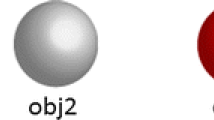Abstract
We describe a classification-based approach to referring expression generation (REG) making use of standard context-related features, and an extension that adds speaker-related features. Results show that taking speakers’ preferences into account outperforms the standard REG model in four test corpora of definite descriptions.
Access this chapter
Tax calculation will be finalised at checkout
Purchases are for personal use only
Preview
Unable to display preview. Download preview PDF.
Similar content being viewed by others
References
Bohnet, B.: The fingerprint of human referring expressions and their surface realization with graph transducers. In: INLG 2008, Stroudsburg, USA, pp. 207–210 (2008)
Dale, R., Reiter, E.: Computational interpretations of the Gricean maxims in the generation of referring expressions. Cognitive Science 19(2), 233–263 (1995)
Dice, L.R.: Measures of the amount of ecologic association between species. Ecology 26(3), 297–302 (1945)
Fabbrizio, G.D., Stent, A.J., Bangalore, S.: Trainable speaker-based referring expression generation. In: Proceedings of the Twelfth Conference on Computational Natural Language Learning, CoNLL 2008, Stroudsburg, PA, USA, pp. 151–158 (2008), http://dl.acm.org/citation.cfm?id=1596324.1596350
Ferreira, T.C., Paraboni, I.: Classification-based referring expression generation. In: Gelbukh, A. (ed.) CICLing 2014, Part I. LNCS, vol. 8403, pp. 481–491. Springer, Heidelberg (2014)
Gupta, S., Stent, A.J.: Automatic evaluation of referring expression generation using corpora. In: Proceedings of the 1st Workshop on Using Corpora in Natural Language Generation (UCNLG), Birmingham, pp. 1–6 (2005)
Iacovelli, D., Galindo, M.R., Paraboni, I.: Lausanne: A framework for collaborative online NLP experiments. In: 11th International Conference on Computational Processing of Portuguese, PROPOR 2014 (to appear, 2014)
Knerr, S., Personnaz, L., Dreyfus, G.: Single-layer learning revisited: A stepwise procedure for building and training a neural network. In: Soulié, F., Hérault, J. (eds.) Neurocomputing. NATO ASI Series, vol. 68, pp. 41–50. Springer (1990)
Krahmer, E., van Deemter, K.: Computational generation of referring expressions: A survey. Computational Linguistics 38(1), 173–218 (2012)
de Lucena, D.J., Pereira, D.B., Paraboni, I.: From semantic properties to surface text: The generation of domain object descriptions. Inteligencia Artificial. Revista Iberoamericana de Inteligencia Artificial 14(45), 48–58 (2010)
Pereira, D.B., Paraboni, I.: Statistical surface realisation of portuguese referring expressions. In: Nordström, B., Ranta, A. (eds.) GoTAL 2008. LNCS (LNAI), vol. 5221, pp. 383–392. Springer, Heidelberg (2008)
Teixeira, C.V.M., Paraboni, I., da Silva, A.S.R., Yamasaki, A.K.: Generating relational descriptions involving mutual disambiguation. In: Gelbukh, A. (ed.) CICLing 2014, Part I. LNCS, vol. 8403, pp. 492–502. Springer, Heidelberg (2014)
Viethen, J., Dale, R.: The use of spatial relations in referring expression generation. In: INLG 2008, Stroudsburg, USA, pp. 59–67 (2008)
Viethen, J., Dale, R.: Speaker-dependent variation in content selection for referring expression generation. In: Proceedings of the Australasian Language Technology Association Workshop 2010, Melbourne, Australia, pp. 81–89 ( December 2010)
Viethen, J., Dale, R.: GRE3D7: A corpus of distinguishing descriptions for objects in visual scenes. In: Proceedings of the UCNLG+Eval: Language Generation and Evaluation Workshop, Edinburgh, Scotland, pp. 12–22 (July 2011)
Viethen, J., Mitchell, M., Krahmer, E.: Graphs and spatial relations in the generation of referring expressions. In: EACL 2013, Sofia, pp. 72–81 (2013)
Author information
Authors and Affiliations
Editor information
Editors and Affiliations
Rights and permissions
Copyright information
© 2014 Springer International Publishing Switzerland
About this paper
Cite this paper
Ferreira, T.C., Paraboni, I. (2014). Referring Expression Generation: Taking Speakers’ Preferences into Account. In: Sojka, P., Horák, A., Kopeček, I., Pala, K. (eds) Text, Speech and Dialogue. TSD 2014. Lecture Notes in Computer Science(), vol 8655. Springer, Cham. https://doi.org/10.1007/978-3-319-10816-2_65
Download citation
DOI: https://doi.org/10.1007/978-3-319-10816-2_65
Publisher Name: Springer, Cham
Print ISBN: 978-3-319-10815-5
Online ISBN: 978-3-319-10816-2
eBook Packages: Computer ScienceComputer Science (R0)




